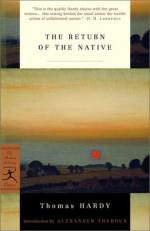The face was well shaped, even excellently. But the mind within was beginning to use it as a mere waste tablet whereon to trace its idiosyncrasies as they developed themselves. The beauty here visible would in no long time be ruthlessly over-run by its parasite, thought, which might just as well have fed upon a plainer exterior where there was nothing it could harm. Had Heaven preserved Yeobright from a wearing habit of meditation, people would have said, “A handsome man.” Had his brain unfolded under sharper contours they would have said, “A thoughtful man.” But an inner strenuousness was preying upon an outer symmetry, and they rated his look as singular.
Hence people who began by beholding him ended by perusing him. His countenance was overlaid with legible meanings. Without being thought-worn he yet had certain marks derived from a perception of his surroundings, such as are not unfrequently found on men at the end of the four or five years of endeavour which follow the close of placid pupilage. He already showed that thought is a disease of flesh, and indirectly bore evidence that ideal physical beauty is incompatible with emotional development and a full recognition of the coil of things. Mental luminousness must be fed with the oil of life, even though there is already a physical need for it; and the pitiful sight of two demands on one supply was just showing itself here.
When standing before certain men the philosopher regrets that thinkers are but perishable tissue, the artist that perishable tissue has to think. Thus to deplore, each from his point of view, the mutually destructive interdependence of spirit and flesh would have been instinctive with these in critically observing Yeobright.
As for his look, it was a natural cheerfulness striving against depression from without, and not quite succeeding. The look suggested isolation, but it revealed something more. As is usual with bright natures, the deity that lies ignominiously chained within an ephemeral human carcase shone out of him like a ray.
The effect upon Eustacia was palpable. The extraordinary pitch of excitement that she had reached beforehand would, indeed, have caused her to be influenced by the most commonplace man. She was troubled at Yeobright’s presence.
The remainder of the play ended: the Saracen’s head was cut off, and Saint George stood as victor. Nobody commented, any more than they would have commented on the fact of mushrooms coming in autumn or snowdrops in spring. They took the piece as phlegmatically as did the actors themselves. It was a phase of cheerfulness which was, as a matter of course, to be passed through every Christmas; and there was no more to be said.
They sang the plaintive chant which follows the play, during which all the dead men rise to their feet in a silent and awful manner, like the ghosts of Napoleon’s soldiers in the Midnight Review. Afterwards the door opened, and Fairway appeared on the threshold, accompanied by Christian and another. They had been waiting outside for the conclusion of the play, as the players had waited for the conclusion of the dance.




